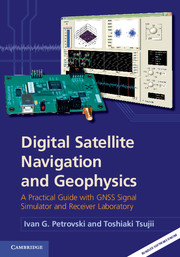 Digital Satellite Navigation and Geophysics
Digital Satellite Navigation and Geophysics Book contents
- Frontmatter
- Contents
- Foreword
- Preface
- 1 Methods of positioning with navigation satellites
- 2 Presentations and applications of GNSS orbits
- 3 GNSS signal generation in transmitters and simulators
- 4 Signal propagation throughthe atmosphere
- 5 Receiver RF front end
- 6 Real-time baseband processor on a PC
- 7 Multipath
- 8 Optimization of GNSS observables
- 9 Using observables in navigation-related tasks
- 10 Electromagnetic scintillation of GNSS signal
- 11 Geophysical measurements using GNSS signals
- 12 Aiding baseband and navigation processors using INS
- Next step – RF lab
- Index
- References
5 - Receiver RF front end
Published online by Cambridge University Press: 05 March 2012
- Frontmatter
- Contents
- Foreword
- Preface
- 1 Methods of positioning with navigation satellites
- 2 Presentations and applications of GNSS orbits
- 3 GNSS signal generation in transmitters and simulators
- 4 Signal propagation throughthe atmosphere
- 5 Receiver RF front end
- 6 Real-time baseband processor on a PC
- 7 Multipath
- 8 Optimization of GNSS observables
- 9 Using observables in navigation-related tasks
- 10 Electromagnetic scintillation of GNSS signal
- 11 Geophysical measurements using GNSS signals
- 12 Aiding baseband and navigation processors using INS
- Next step – RF lab
- Index
- References
Summary
We have described how a GNSS signal is generated in Chapter 3. In Chapter 4 we examined how a GNSS signal propagates through the Earth’s atmosphere. In this chapter we discuss how a radio frequency signal is converted by a GNSS receiver front end to a digital format for further processing. The scope of this chapter is shown schematically in Figure 5.1. The purpose of this chapter is to describe a design of a receiver front end and the operations of its major components, and to analyze how the design of these components affects a GNSS signal.
Generic GNSS receiver
A generic receiver flowchart is presented in Figure 5.2. The receiver in the flowchart does not include a navigation processor. A receiver acquires a radio frequency (RF) signal coming through atmosphere from a satellite. The signal goes to a front end. On the output of the front end we have a digitized intermediate frequency signal, which can then be processed either in digital hardware or in the software. In the front end the signal is filtered by a bandpass filter and then down-converted from RF to intermediate frequency (IF). (Figure 5.3 shows an example of a simplified frequency plan for the front end.) Next the IF signal goes through an analog to digital converter (ADC), and the resulting digitized IF (DIF) signal goes from the front end to a baseband processor. The baseband processor performs signal acquisition and tracking. The acquisition and tracking are achieved by means of correlating the incoming signal in the shape of DIF with a replica signal which is generated within the receiver. The baseband processor outputs raw measurements, in particular code phase, carrier phase, Doppler, and signal-to-noise ratio (SNR) measurements. Baseband processor operation is described in detail in the next chapter.
Information
- Type
- Chapter
- Information
- Digital Satellite Navigation and GeophysicsA Practical Guide with GNSS Signal Simulator and Receiver Laboratory, pp. 127 - 154Publisher: Cambridge University PressPrint publication year: 2012